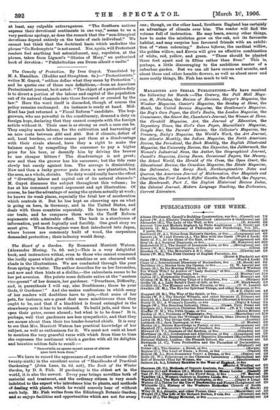The Heart of a Garden. By Rosamund Marriott Watson. (Alexander
Moring. 7s. 6d. net.)—This is a very delightful book, and instructive withal, even to those who cannot command the lordly spaces which glow with sunshine or are obscured with shade in the illustrations. We are conducted through the year from spring to winter. The author describes for us her favourites, and now and then hints at a dislike,—the calceolaria seems to be her pet aversion. She points some delicate satire at the "austere vice-gerent" of her domain, her gardener. "Dwarfness, Difficulty, and, in parenthesis I will say, also Doubleness ; these be your Gods, 0 Gardener !" And she makes confessions in which many of her readers will doubtless have to join,—that some of her pets, for instance, are a great deal more mischievous than they ought to be, and that if a blackbird is found entangled in the strawberry-nets it has to be released. To build jails, and then to open their gates, seems absurd ; but what is to be done ? It is, perhaps, well that gardeners are less sympathetic, and that they are sooner about than their too tender-hearted chiefs. It is easy to see that Mrs. Marriott Watson has practical knowledge of her subject, as well as enthusiasm for it. We must not omit at least to mention the very graceful verse with which from time to time she expresses the sentiment which a garden with all its delights and beauties seldom fails to recall
Immortalia ne spere.s monet annus et almum quae tent hors diem."
—We have to record the appearance of yet another volume (the twenty-sixth) in the excellent series of "Handbooks of Practical Gardening" (John Lane, 28. Gd. net), The Book of the Winter Garden, by D. S. Fish. If gardening is the oldest art in the world, it is also the newest. Every year brings novelties both of material and treatment, and the ordinary citizen is very mu& indebted to the expert who introduces him to plants, and methods of &sling with plants, which he would scarcely hear of without such help. Mr. Fish writes from the Edinburgh Botanic Garden, and so enjoys facilities and opportunities which are not for every one ; though, on the other hand, Southern England has certainly an advantage of climate over him. The reader will find the volume full of instruction. He may learn, among other things, how to make the mistletoe grow on the oak, not its favourite habitat, and may surprise less favoured friends with an exhibi- tion of "stem colouring." Rubens billorus, the cardinal willow, the golden willow, and Kerria will give an effective combination of white, red, yellow, and green. "These should be planted three feet apart and in fifties rather than fives." This is, perhaps, a little discouraging to the ambitions master of a suburban garden. But we can all have crocus and aconite, and about these and other humble flowers, as well as about rarer and more costly things, Mr. Fish has much to tell us.










































 Previous page
Previous page